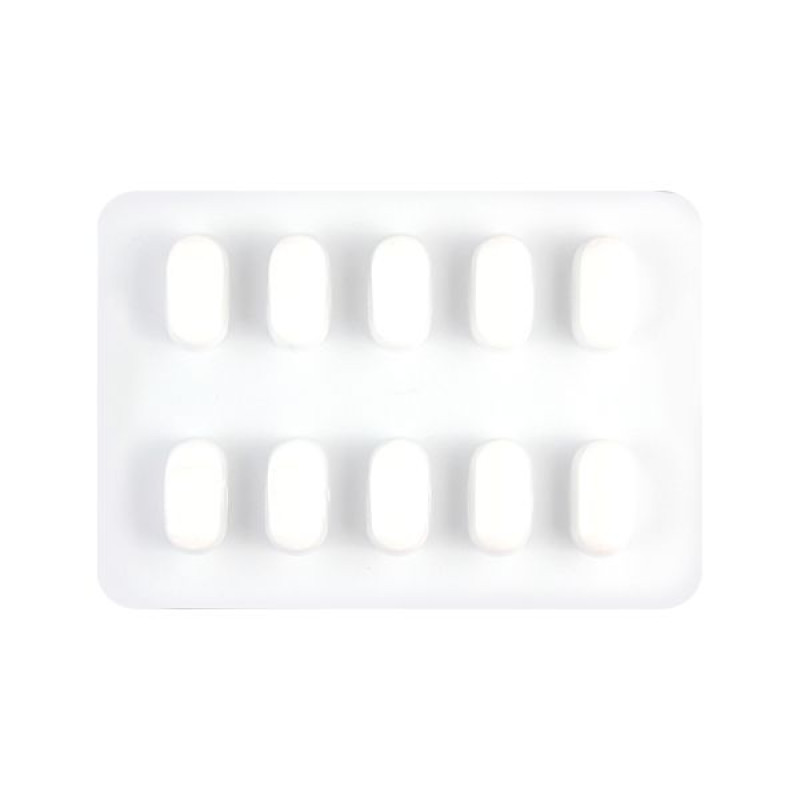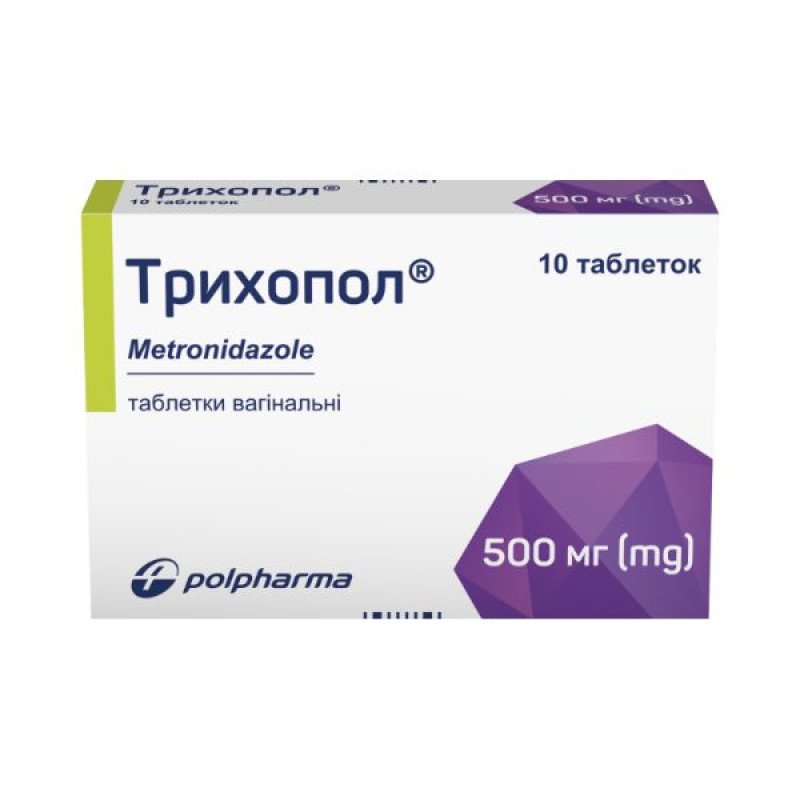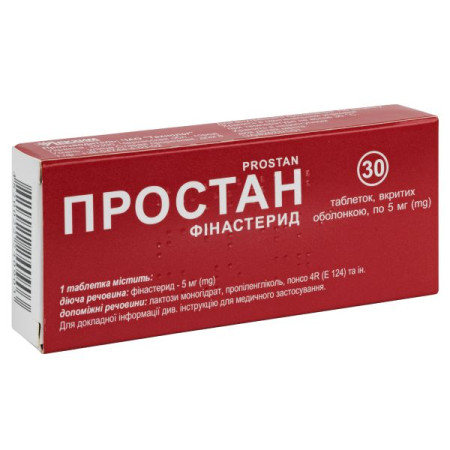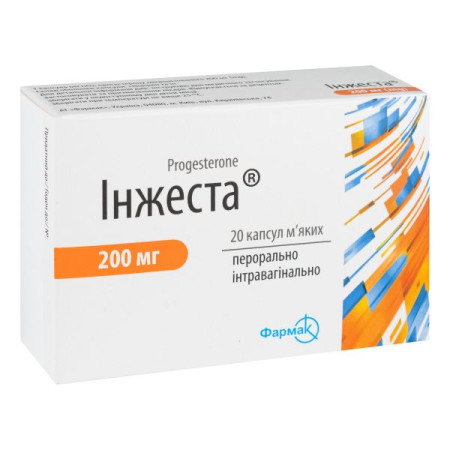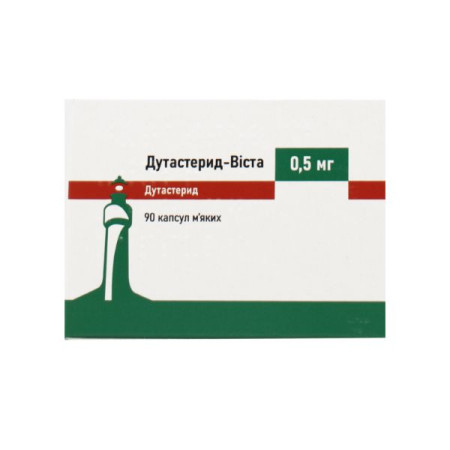Trichopol vaginal tablets 500 mg No. 10
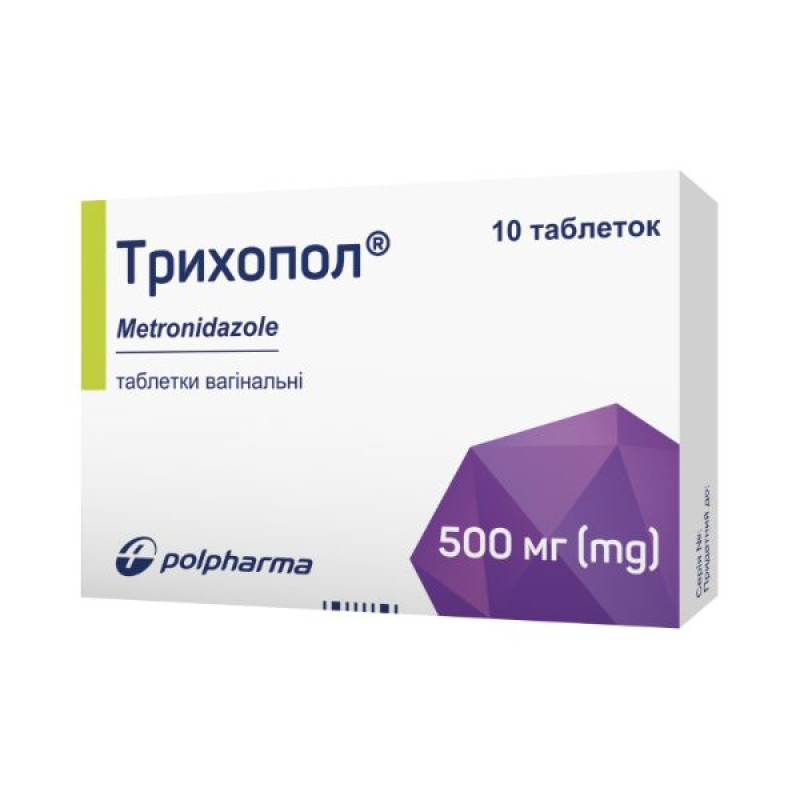
Pharmacological properties
Pharmacodynamics. Metronidazole belongs to nitro-5-imidazole derivatives and has a broad spectrum of action. The limit concentrations that allow to differentiate sensitive strains (s) from strains with moderate sensitivity, and strains with moderate sensitivity from resistant strains (r), are s≤4 mg/l and r 4 mg/l.
The prevalence of acquired resistance in certain species of microorganisms may vary with geographical location and time. Therefore, it is useful to have information on the local prevalence of resistance, especially when treating severe infections. These data are general guidelines that indicate the likelihood of susceptibility of a particular bacterial strain to that antibiotic.
The following are sensitive to the drug: Peptostreptococcus spp., Clostridium spp., Bacteroides spp., Fusobacterium spp., Porphyromonas, Bilophila, Helicobacter pylori, Prevotella spp., Veilonella. Metronidazole inhibits the development of protozoa - Trichomonas vaginalis, Giardia intestinalis (Lamblia intestinalis), Entamoebahistolytica.
The following microorganisms are not consistently sensitive to the drug: Bifidobacterium spp., Eubacterium spp. Insensitive strains of microorganisms: Propionibacterium, Actinomyces, Mobiluncus.
Pharmacokinetics. Absorption. When taken orally, metronidazole is rapidly and almost completely absorbed (at least 80% in 1 hour). C max in blood plasma, reached after oral administration of the drug, is similar to that achieved after intravenous administration of equivalent doses.
Oral bioavailability is 100%. It is not significantly reduced when taken with food.
Distribution: Approximately 1 hour after a single dose of 500 mg, the mean Cmax in plasma is 10 μg/ml.
Biotransformation. Metabolism occurs mainly in the liver: 2 unconjugated oxidized active metabolites are formed (5-30% of activity):
- the main “alcohol” metabolite, which provides about 30% of the antibacterial activity of metronidazole against anaerobic bacteria, with T ½ - about 11 hours;
- an "acidic" metabolite, which is present in smaller quantities and provides about 5% of the antibacterial activity of metronidazole.
Excretion: Excretion is mainly by the kidneys: 35-65% of the dose taken is excreted in the urine in the form of metronidazole and its oxidized metabolites.
After vaginal administration, systemic penetration is minimal. T ½ is 8-10 hours. Binding to plasma proteins is insignificant (20%). Rapid and pronounced diffusion into the lungs, kidneys, liver, bile, cerebrospinal fluid, skin, saliva and vaginal secretion. Penetrates the placental barrier and into breast milk. Metabolism occurs mainly in the liver: 2 unconjugated oxidized active metabolites are formed (5-30% of activity).
Excretion - mainly by the kidneys: 35-65% of the dose taken is excreted in the urine in the form of metronidazole and its oxidized metabolites.
Indication
Infections caused by microorganisms sensitive to the drug: amebiasis, urogenital trichomoniasis, nonspecific vaginitis, giardiasis, surgical infections caused by anaerobic microorganisms sensitive to metronidazole, replacement of intravenous treatment of infections caused by anaerobic microorganisms sensitive to metronidazole.
Application
The drug is used only in adults.
Pills.
For amebiasis, take Trichopol for 7 days. Adults 1.5 g/day (in 3 divided doses); children (with body weight ≥20 kg): 30-40 mg/kg body weight per day, divided into 3 divided doses.
In the event of a liver abscess due to amebiasis, drainage or aspiration of pus is performed simultaneously with metronidazole therapy.
Treat giardiasis for 5 days. Adults should be prescribed 750-1000 mg of Trichopol per day; children aged 10-15 years - 500 mg 2 times a day.
For trichomoniasis in women (urethritis and vaginitis caused by Trichomonas), the course of treatment with Trichopolum is 10 days, combining 1 tablet 2 times a day and 1 vaginal suppository (500 mg) per day. The sexual partner should be treated at the same time, regardless of the presence or absence of clinical signs of Trichomonas infection, even if the result of laboratory tests is negative.
For trichomoniasis in men (urethritis caused by Trichomonas), the course of treatment with Trichopol is 10 days, 1 tablet 2 times a day.
In exceptional cases, it may be necessary to increase the daily dose to 0.750 g or 1 g.
For nonspecific vaginitis, prescribe 500 mg of Trichopol 2 times a day for 7 days. The partner should be treated at the same time.
For the treatment of anaerobic infections (first-line therapy or replacement therapy), adults should be prescribed 1.0-1.5 g of Trichopol per day, children over 6 years of age (with a body weight ≥16 kg) - at the rate of 20-30 mg/kg/day).
vaginal tablets
Trichomonas vaginitis. Prescribe 1 vaginal tablet once a day for 10 days. Before inserting into the vagina, the tablet should be slightly moistened in cooled boiled water. Treatment should be carried out with simultaneous oral administration of Trichopol tablets. Treatment should not be stopped during menstruation.
Nonspecific vaginitis. 1 vaginal tablet should be inserted deep into the vagina once a day for 7 days. If necessary, Trichopol tablets can be administered orally.
Simultaneous treatment of the patient's sexual partner is recommended, even if he or she has no symptoms of infection.
The maximum duration of treatment should not exceed 10 days, the number of treatment courses - 2-3 per year.
Hypersensitivity to metronidazole or other components of the drug, I trimester of pregnancy, breastfeeding. Hypersensitivity to imidazole derivatives. This drug is not recommended to be prescribed in combination with disulfiram or taken simultaneously with alcohol (see interactions), children's age up to 6 years, which is due to the dosage form.
Side effects
Gastrointestinal: epigastric pain, nausea, vomiting, diarrhea, inflammation of the oral mucosa (glossitis with dry mouth, stomatitis, coated tongue), taste disorders, anorexia, isolated cases of pancreatitis, which are reversible.
On the part of the skin and its derivatives: rash, itching, skin hyperemia, urticaria, fever, angioedema, anaphylactic shock, pustular rash, flushing with hyperemia, erythema multiforme, Stevens-Johnson syndrome, toxic epidermal necrolysis, sometimes - febrile manifestations, tongue discoloration, "hairy tongue" (due to excessive development of fungal flora).
Nervous system: ataxia, drowsiness, headache, convulsions, dizziness, encephalopathy (e.g. confusion, fever, increased sensitivity to light, torticollis, hallucinations, paralysis, visual and movement disorders); aseptic meningitis, sensory peripheral neuropathies or transient epileptic seizures, dysarthria, gait disturbance, nystagmus, tremor.
On the part of the organ of vision: temporary visual disturbances such as diplopia, myopia, decreased visual acuity, changes in color perception, optic neuropathy/neuritis, photosensitivity.
Psychiatric: mental disorders, including confusion, depressed mood, hallucinations.
From the blood and lymphatic system: agranulocytosis, neutropenia and thrombocytopenia, pancytopenia, leukopenia.
Hepatobiliary system: increased activity of liver enzymes (AST, ALT, LF), cholestatic or mixed hepatitis and damage to liver cells, sometimes jaundice; liver failure requiring liver transplantation in patients taking metronidazole in combination with other antibiotics.
Other adverse reactions: increased body temperature.
During treatment, urine may become red-brown in color, which is due to the presence of water-soluble pigments, which are products of metronidazole metabolism.
Special instructions
Long-term use of the drug requires laboratory blood monitoring. If the patient develops leukopenia, it is important to carefully assess the ratio of the expected benefit of continuing treatment and the possible risk. It is necessary to remember the risk of worsening neurological status in patients with severe, chronic or acute neurological diseases during treatment with metronidazole.
Trichopol should be prescribed with great caution to patients with permanent or progressive neuropathies.
Treatment should be discontinued if ataxia, dizziness, hallucinations, or worsening of the patient's neurological status occur. Metronidazole is capable of immobilizing treponema, which leads to a false-positive Nelson test.
The drug should be used with caution in patients with hepatic encephalopathy. In patients with hepatic encephalopathy, the dose should be reduced by one third and can be used once a day. In patients undergoing hemodialysis, metronidazole and its metabolites are excreted within 8 hours of hemodialysis, so metronidazole should be taken immediately after hemodialysis. There is no need to change the dose in patients with renal failure undergoing peritoneal dialysis.
There is a possibility of persistence of gonococcal infection after elimination of Trichomonas infection.
During treatment with metronidazole, alcohol consumption should be avoided, as tachycardia, vomiting, and a feeling of heat may occur.
Using the vaginal pill at the same time as using a condom or vaginal diaphragm may increase the risk of latex rupture.
Treatment with Trichopol should be discontinued if ataxia, dizziness, or confusion occur.
It is important to remember the possible risk of worsening neurological status in patients with severe, chronic or active disorders of the central or peripheral nervous system.
Precautions for use. The drug is not considered to pose a carcinogenic risk to humans, although a carcinogenic effect has been found in some strains of mice. However, this effect has not been observed in rats or hamsters.
If there is a history of hematological disorders or treatment is carried out with high doses of metronidazole and/or for a long time, regular monitoring of the leukocyte count is recommended.
There is a possibility of persistence of gonococcal infection after elimination of Trichomonas vaginalis.
Metronidazole should be prescribed with caution to patients who have taken corticosteroids and are prone to edema.
Patients who have noticeable changes in blood parameters after and before treatment with metronidazole should be observed by a doctor if repeated use of metronidazole is necessary.
Oral, vaginal, and gastrointestinal candidiasis may develop after metronidazole use, which may require appropriate treatment.
Pregnancy. Animal studies have not shown a teratogenic effect. Since no teratogenic effect has been observed in animals, no malformations are expected in humans. According to data, substances that cause malformations in humans have been shown to be teratogenic in animals in adequately conducted studies in two species. From a clinical point of view, no fetotoxic effects on pregnancy have been observed after the analysis.
However, further epidemiological studies are needed to confirm the absence of risk. Therefore, metronidazole should be prescribed during pregnancy only if clearly needed and the potential benefit outweighs the potential risk.
Breastfeeding. Metronidazole passes into breast milk. Trichopolum should not be used during breastfeeding.
Children. The drug in the form of 250 mg tablets can be used in children aged 6 years and older.
Interactions
Combinations that are not recommended
Disulfiram: Cases of psychiatric reactions (delirium, confusion) have been reported in patients taking metronidazole and disulfiram concomitantly.
Alcohol: You should not drink alcoholic beverages or take medications containing alcohol during treatment and for at least 1 day after its completion due to the possible occurrence of a disulfiram-like reaction (antabus effect, flushing, erythema, hyperemia, vomiting, tachycardia).
Busulfan: Metronidazole may increase plasma levels of busulfan, which may lead to significant busulfan toxicity.
Combinations that should be used with caution
Oral anticoagulant therapy (warfarin): increased anticoagulant effect and increased risk of bleeding due to decreased hepatic catabolism. In case of concomitant use, prothrombin time should be monitored more frequently and anticoagulant therapy should be adjusted during treatment with metronidazole and for 8 days after its discontinuation.
Trichopol does not interact with heparin.
Fluorouracil: decreased clearance of fluorouracil and increased toxicity.
Lithium: Plasma lithium levels may increase when metronidazole is administered. Plasma lithium concentrations, creatinine and electrolytes should be monitored in patients receiving lithium and metronidazole concomitantly.
Cyclosporine: risk of increased plasma levels of cyclosporine. If concomitant use is necessary, cyclosporine and creatinine levels should be closely monitored.
Phenytoin or phenobarbital: causes a decrease in the plasma level of metronidazole.
International normalized ratio (INR) changes: Numerous cases of increased activity of oral anticoagulants have been reported in patients receiving antibacterial therapy. Risk factors that predispose to this complication include the presence of infections or severe inflammation, age and general health. In these circumstances, it is difficult to determine to what extent the INR imbalance is caused by the infection itself or its treatment. However, some classes of antibiotics play a major role in this, in particular: fluoroquinolones, macrolides, cyclines, trimoxazole and some cephalosporins.
Overdose
A single dose of no more than 12 g has been recorded during suicide attempts and accidental overdose.
Leukopenia, neuropathy, ataxia, vomiting may occur. Since a specific antidote to metronidazole is unknown, symptomatic therapy is recommended.
Storage conditions
In the original packaging at a temperature not exceeding 25 ° C. Store out of the reach of children.
There are no reviews for this product.
There are no reviews for this product, be the first to leave your review.
No questions about this product, be the first and ask your question.







